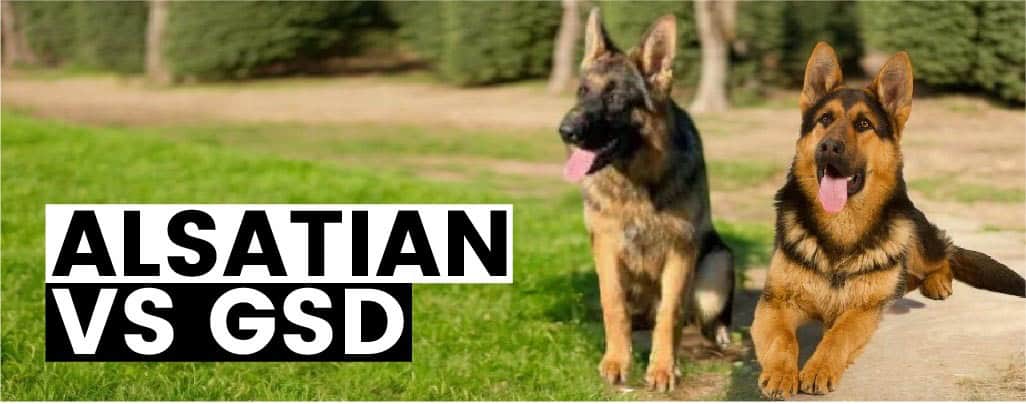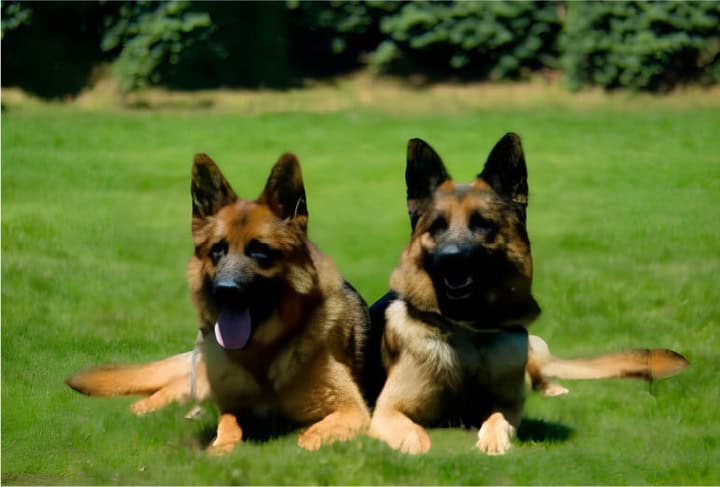
The debate between German Shepherd and Alsatians often sparks curiosity among dog enthusiasts.
Are these two distinct breeds, or simply different names for the same dog?
When talking about Alsatian vs German Shepherd dogs, many people find themselves confused by these terms, thinking they might refer to different breeds or types of dogs. The answer lies in a fascinating history of war, cultural sensitivity, and breed recognition. Many people use the names interchangeably without knowing the reasons behind these two names; they share historical and political climates for their identity.
This post explains the background and usage of the names “Alsatian” and “German Shepherd,” clarifying how this remarkable breed came to be known by two different names in various parts of the world.
QUICK SUMMARY:
- The origin of the German Shepherd breed, developed in Germany in 1899, and how it became known for its intelligence and agility.
- The reason why the British adopted the name “Alsatian” during World War I was to avoid anti-German sentiment and its association with the Alsace-Lorraine region.
- The post outlines the gradual transition back to the original “German Shepherd” name after World War II and how both names coexisted for some time.

Are Alsatians and German Shepherds the Same?
Yes, Alsatians and German Shepherd Dogs are the same breed. The distinction between the two names originates from historical and political circumstances rather than any difference in the dogs themselves.
What is an Alsatian? The term “Alsatian” has its roots in history, specifically in Europe during the early 20th century. The name is derived from the Alsace region of France, which shares a border with Germany. During World War I, when anti-German sentiment was high, the British wanted to avoid associating the breed with Germany.
Originally known as the Deutscher Schäferhund, which translates to German Shepherd Dog, this breed has a long history dating back to 1899. It was first developed as a working dog by Captain Max von Stephanitz in Germany. The German Shepherd quickly gained recognition for its remarkable agility and intelligence, becoming a prominent figure in World War I and World War II due to its exceptional performance and versatility.
The Impact of World Wars on the GSD Name Change
During World War I, the British engaged in intense battles with German forces, seeking to distance themselves from anything associated with Germany. The Alsace-Lorraine region, located between France and Germany, was significant in these conflicts. Although the British admired the German Shepherd for its outstanding abilities, they decided to rename the breed “Alsatian” to avoid any German associations. The Alsace-Lorraine region inspired this name.
Post-War Period and Name Evolution
After World War II, the term “German” remained unfavorable due to lingering anti-German sentiments. As a result, “Alsatian” continued to be used in many places. The Alsace Club and the American Kennel Club reinstated the original “German Shepherd Dog” name around 1925. However, the UK Kennel Club retained “Alsatian,” with “German Shepherd” listed in brackets.
Official Reversion to German Shepherd
In 1977, the breed name officially reverted to “German Shepherd,” with “Alsatian” listed in brackets. It wasn’t until 2010 that “Alsatian” was completely phased out. Today, the breed is officially known as the German Shepherd, reflecting its original name and heritage. Despite the historical use of “Alsatian,” both names refer to the same breed, recognized for its intelligence, loyalty, and versatility.
The historical context helps clarify that whether called an Alsatian or German Shepherd, the dog remains the same in appearance, behavior, and characteristics.
A Quick Glance on Alsatian vs German Shepherd Attributes
Alsatian is similar to German Shepherd, but the major points that make them different from each other are in this table.
| Aspects | Alsatian🐾 | German Shepherd (GSD)🐾 |
|---|---|---|
| Origins | The term originated in the UK | Germany |
| Reason for Name | Adopted to avoid anti-German sentiment | Reflects German origin |
| Modern Name Recognition | Less commonly used today | Widely recognized by international breed registries |
| Historical Context | Name change during/after World Wars | Maintained original name globally |
| Current Popularity | Mainly used in the UK, declining | Very popular worldwide |
A Detailed Comparative Look at Alsatians and German Shepherd Dogs

Here are some points that are common in both breeds and some that make them different from each other.
1. Physical Characteristics – Alsatian vs GSD
Both Alsatians and German Shepherds share many physical characteristics due to their common lineage. They are medium to large-sized dogs with a strong and athletic build. The breed is known for its distinctive appearance, including a straight back, powerful limbs, and a bushy tail.
| Features | Alsatians | German Shepherds |
|---|---|---|
| Size | Male between 75-95 pounds/
Females weigh 50-70 pounds |
Males weighing 75-95 pounds Females 50-70 pounds. |
| Coat | Black and tan, sable, and all black | Black and tan, sable, and all black. |
| Body Structure: | Muscular build, with a sloping back that is characteristic of the breed. | Strong, athletic build and a dense coat. |
Overall, the physical differences between Alsatian vs GSD are minimal, and they often appear identical in terms of appearance.
Breed standards for both names are almost identical. The German Shepherd breed standard emphasizes a well-balanced and functional dog capable of performing various tasks. The Alsatian breed standard, when it was in use, also mirrored these traits, reflecting the shared heritage of the two names.
2. Temperament and Behavior – German Shepherds vs Alsatian Dogs
Both Alsatians and German Shepherds are known for their intelligence, loyalty, and versatility. They are highly trainable and often excel in various roles, including police work, search and rescue, and as service dogs. Their temperament is generally characterized by:
-
- Both breeds are quick learners and thrive on mental stimulation.
- They form strong bonds with their families and are protective of their loved ones.
- These breeds are active and require regular exercise to stay healthy and happy.
3. Training and Intelligence – GSD vs Alsatians
Training is one of the strong suits of both Alsatians and German Shepherds. They are highly responsive to commands and enjoy working with their owners. Their intelligence makes them excellent candidates for advanced training and obedience work.
The training approach for both breeds is similar. Positive reinforcement techniques work best, as these breeds respond well to praise and rewards. Consistent training and socialization from a young age are crucial to ensuring that they grow into well-behaved adults.
4. Popularity and Recognition – Alsatian Dogs vs GSDs
The German Shepherd is officially recognized by major kennel clubs around the world, including the American Kennel Club (AKC) and the Fédération Cynologique Internationale (FCI). The breed is known for its high standards and is often featured in dog shows and competitions.
The German Shepherd enjoys widespread popularity worldwide. It is one of the most recognized and favored breeds for various roles, including family pets, working dogs, and show dogs. Its versatility and impressive qualities contribute to its global appeal.
In contrast, the Alsatian name is less commonly used today, but the breed’s popularity remains strong in regions where the term is still prevalent. The German Shepherd’s dominance in global recognition has largely overshadowed the use of “Alsatian.”
5. Common Health Issues – Alsatian vs GSD
Both Alsatians and German Shepherds are prone to certain health conditions due to their genetic background. Common health issues include:
Hip Dysplasia: A hereditary condition where the hip joint doesn’t fit into the hip socket properly, leading to arthritis and pain.
Elbow Dysplasia: Similar to hip dysplasia, this condition affects the elbow joint and can cause lameness and discomfort.
Gastric Dilatation-Volvulus (GDV): Also known as bloat, this is a life-threatening condition that causes the stomach to fill with gas and twist.
Regular veterinary check-ups and maintaining a healthy weight can help manage and prevent these issues. Both breeds benefit from a balanced diet, regular exercise, and responsible breeding practices to reduce the risk of hereditary health problems.
6. Care Requirements – Alsatian vs German Shepherds
The care requirements for both Alsatians and German Shepherds are quite similar. They need regular grooming to manage their dense double coat, which sheds throughout the year. Brushing several times a week helps reduce shedding and keeps their coat healthy.
Both breeds require ample exercise to meet their high energy levels. Daily walks, playtime, and mental stimulation are essential to keep them physically and mentally fit.
Training and socialization are crucial for both breeds to ensure they develop into well-adjusted adults. Consistent training and exposure to various environments and experiences help prevent behavioral issues and promote a well-rounded temperament.
FAQs
How do Alsatians and German Shepherds handle living in apartments?
Both Alsatians and German Shepherds can adapt to apartment living, provided they receive adequate exercise and mental stimulation. Regular walks, playtime, and enrichment activities are essential to keep them happy and prevent boredom.
What are the common misconceptions about Alsatians and German Shepherds?
Common misconceptions include believing they are overly aggressive or difficult to manage. Both Alsatians and German Shepherds are known for their loyalty, intelligence, and trainability. Proper training and socialization are key to ensuring a well-behaved and balanced dog.
Are there any specific dietary needs for Alsatians/German Shepherds?
Alsatians and German Shepherds benefit from a balanced diet tailored to their age, size, and activity level. High-quality dog food that meets their nutritional needs is essential. Some dogs may require special diets if they have specific health conditions.
The Bottom Line
Alsatians and German Shepherds are essentially the same breed, with the primary difference being the terminology used in various regions and historical contexts. The German Shepherd name reflects the breed’s origins and global recognition, while “Alsatian” was used primarily in the UK during and after World War I.
Both names refer to the same physical and temperamental traits, including intelligence, loyalty, and versatility. The breed’s physical characteristics, health issues, and care requirements are nearly identical, emphasizing that Alsatians and German Shepherds are the same breed.
Ready to Bring a Loyal Companion into Your Home? If you are considering adding one to your family or need expert training for your German Shepherd, contact us today to learn more about how we can help you find the perfect companion.






